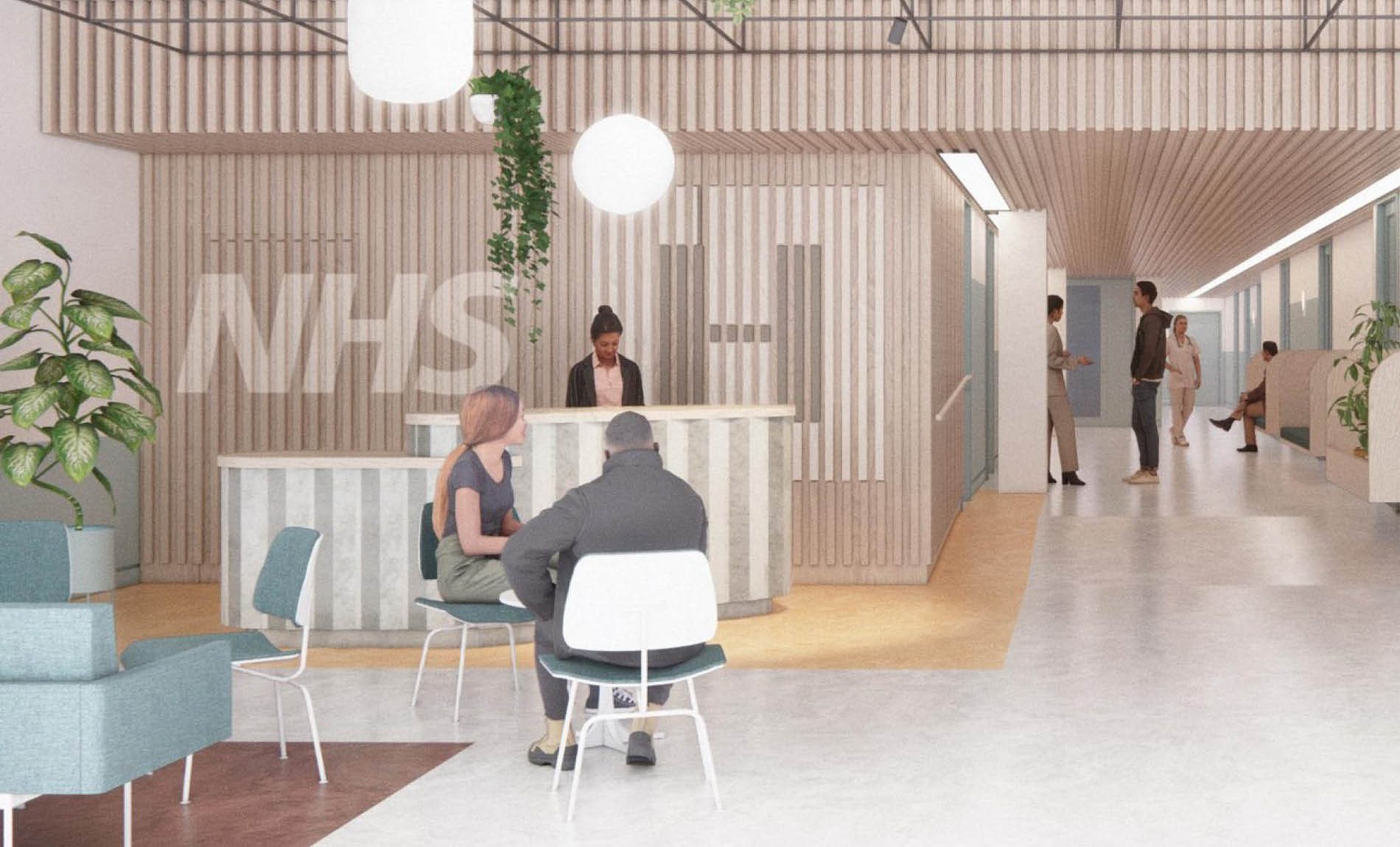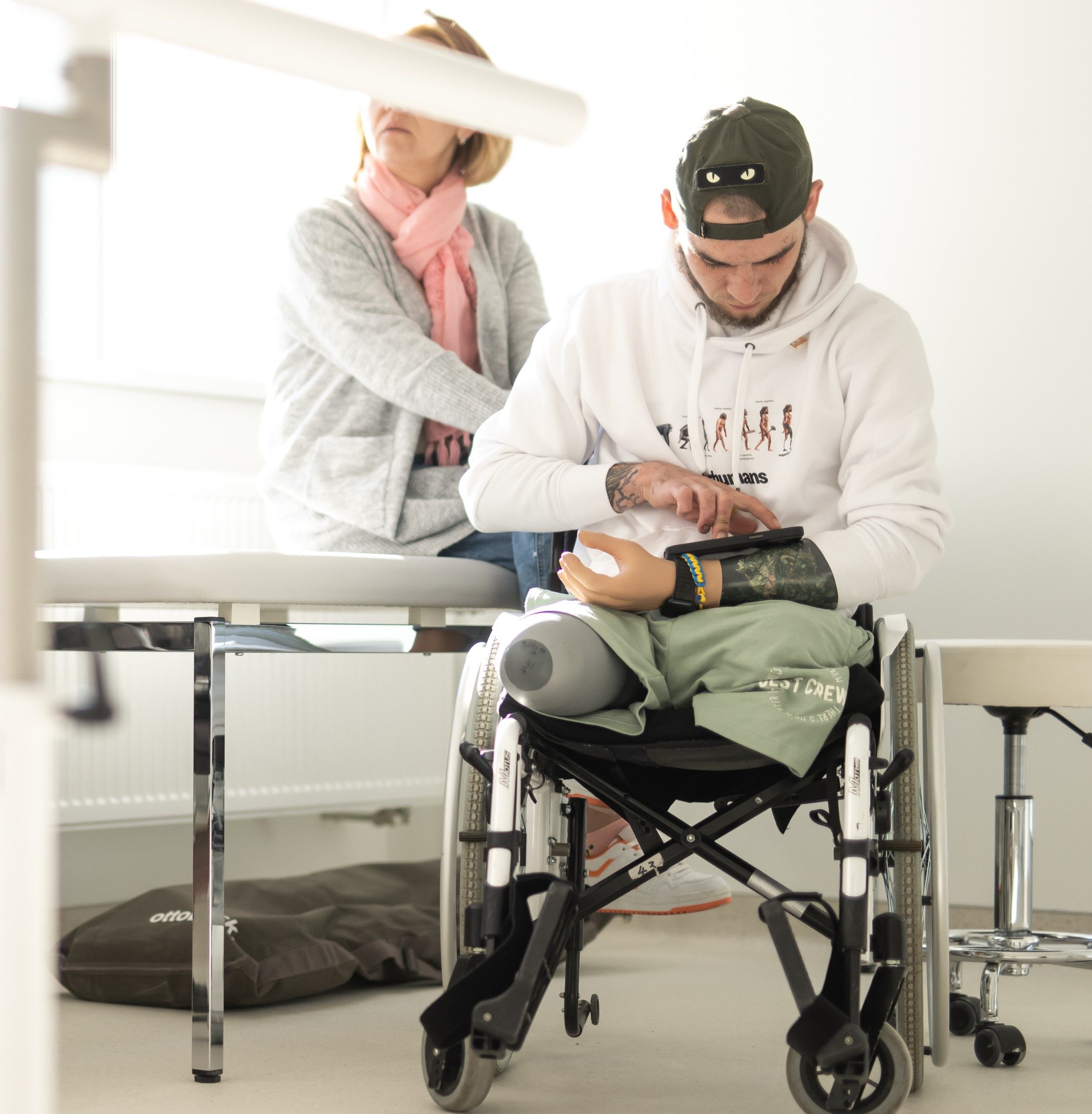
This month we caught up with our healthcare design manager, Valentin, to talk about what he sees could be the future for healthcare design, new ideas and emerging trends.
Bringing healthcare to the community
One of the most significant trends shaping the future of healthcare design is the rise of Community Diagnostic Centres (CDCs), which decentralise healthcare services to bring care closer to patients.
Additionally, we are still seeing the lasting impact of the COVID-19 pandemic and how this has affected the management and co-ordination of healthcare not only during the planning and design of new healthcare spaces, but also their operational processes. Furthermore, the increase of remote and flexible working has transformed the requirements for staff spaces with the need to accommodate hybrid working models, creating spaces that support both in-person and remote working functions, which also plays a key role in the design of future healthcare environments.
The rise of outpatient clinics, Urgent Treatment Centres (UTCs) and home-based case is set to dramatically reshape healthcare design by reducing the need for patients to be physically present in traditional healthcare settings. The smart collection, management and secure transmission of patient data will allow for more remote monitoring and treatment, enabling healthcare professionals to receive accurate information without requiring in-person visits.
This shift could lead to a leaner healthcare system on all levels, where both patients and professionals only travel when necessary, optimising resources and reducing costs. For instance, if patients can collect vital data at home and share it with their healthcare providers through secure digital channels, the need for visits to GPs and acute hospitals could be minimised. This in turn could lead to significant savings in terms of time, fuel, carbon emissions and reduced pressure on transport networks. Underutilised spaces could then be repurposed or redesigned to accommodate more urgent or specialised care, fostering a more efficient and eco-friendly healthcare infrastructure.
Drawing inspiration from Germany’s model, the goal is to extend healthcare services beyond major urban centres.
The healthcare experience for rural areas and underserved communities is likely to evolve through decentralisation, ensuring that all citizens, regardless of location, have access to quality healthcare. Drawing inspiration from Germany’s model, the goal is to extend healthcare services beyond major urban centres.
For remote or hard-to-reach communities – whether within mainland UK, on isolated islands or even in Arctic bases – the most effective solution may lie in pre-constructed modular units (off-site modular construction). Like how ambulances provide mobile healthcare where and when it’s needed, this principle can be expanded to broader applications. Modular healthcare units, such as diagnostic pods, could be quickly deployed by air, sea or lorry to provide essential healthcare services in a flexible, cost-efficient solution while addressing the specific geographical challenges and providing timely care for all.
Embracing technological advancements
Technology is set to play a transformative role in the future of healthcare, not only in the design of spaces but also in the procedures that are carried out, with advances such as telemedicine, AI and robotics becoming integral.
Healthcare has always been at the forefront of technological advancements due to the high complexities embedded in the field, meaning spaces must not only be able to accommodate the current needs, but also be flexible enough to anticipate future advancements and adaptations. Designers must think beyond aesthetics and architecture of the spaces, but also focus on sustainability, cost-efficiency, and reducing carbon footprints to ensure these facilities stand the test of time, both in their functionality and ability to adapt to reshape how healthcare is delivered.
Designers must think beyond aesthetics and architecture of the spaces, but also focus on sustainability, cost-efficiency, and reducing carbon footprints to ensure these facilities stand the test of time.
The growing integration of digital health tools is significantly redefining the functionality and flow of healthcare facilities, altering the design paradigm. Variating spatial requirements to accommodate these technologies may influence the arrangement of patient care areas, staff spaces etc.
The areas needed to house the equipment, data centres and plant rooms also need to be able to evolve. The internal dynamics and flows must be reconsidered to ensure a more streamlined operation of the space. Additionally, the complexity of the mechanical, electrical and plumbing (MEP) systems are increasing, requiring greater interoperability to support the integration of new technologies throughout a healthcare environment.
Data analytics and AI are set to revolutionise the way healthcare spaces are designed and managed, creating more intelligent and responsive environments that can capture and interpret data themselves. For instance, incorporating smart sensors for temperature and ventilation control into the design can allow spaces to adjust their energy output automatically, shutting off or reducing usage when rooms are not in use and ramping up when needed, such as during high occupancy or specific medical procedures.
AI could also be key for streamlining spatial planning by generating optimal layouts for temporary configurations based on real-time input, such as the number of occupants or usage requirements. When temporary facilities were set-up on the onset of COVID-19, for example at London’s Excel Centre, AI could have rapidly generated multiple design options based on factors like flow, safety guidelines, cost, supplier availability, and lead times.
In critical situations, such as pandemics or emergencies in conflict zones, the ability of AI to accelerate the design and decision-making process can be the difference between life and death, making its integration into healthcare design both practical and essential.
Customisable and flexible healthcare spaces
Patient-centred design is likely to evolve into a more customisable and adaptable approach, for example healthcare spaces may become more tailored towards the individual needs of patients, allowing for greater personalisation of their environments.
Just as mobile phones have shifted from a closed system to highly customisable devices where users can install specific apps and features suited to their unique needs, patient spaces could follow a similar evolution. These spaces may be fitted with flexible components that are adjustable to the preferences or medical needs of each patient, allowing for endless combinations within the same core structure, making them more responsive and patient friendly.
We can learn some important tangential lessons from commercial real estate, where mixed-use developments are designed with maximum flexibility from the outset to accommodate potential shifts in tenant needs, market conditions and internal dynamics.
Flexibility is crucial, particularly as healthcare spaces must be able to adapt quickly to ever evolving healthcare needs or crises like pandemics. We can learn some important tangential lessons from commercial real estate, where mixed-use developments are designed with maximum flexibility from the outset to accommodate potential shifts in tenant needs, market conditions and internal dynamics.
Utilising a similar approach in healthcare design would allow spaces to be reconfigured easily as patient demand or medical practices change. While some may argue that this level of adaptability could lead to higher initial costs, these investments will likely be recouped over the building’s lifecycle due to reduced costs associated with renovations, upgrades or changes in use. Designing with flexibility in mind ensures healthcare facilities can continue to function efficiently even in the face of unforeseen challenges or rapid advancements in technology.
Sustainability
Sustainability is increasingly shaping healthcare design, as the construction industry is a major contributor to carbon emissions. One key approach to reducing the environmental impact of healthcare facilities is prioritising the re-use and conversion of existing buildings on the estate which not only preserves resources, but also aligns with broader goals of minimising carbon footprint.
The UK can learn valuable lessons from countries like Germany, which is a leader in reusing and adapting its building stock for new purposes. Focusing on practices like recycling materials, converting existing structures and reducing waste healthcare design can become more eco-friendly. Sustainable innovations will likely include energy-efficient systems, greener materials and modular designs that allow buildings to evolve over time without needing significant reconstruction.
Biophilic design
To reduce stress and promote recovery through the physical environment, new design approaches need to embrace the long-recognised principles of biophilic design, which emphasise the healing benefits of nature. This concept has been discussed for over a century, dating back to influential works such as Alvar Aalto’s Paimio Sanatorium in Finland, bring nature more into the equation and focus on the healing capabilities of the natural environment itself.
Future designs should prioritise ample access to natural light, outdoor views and greenery, fostering a calming atmosphere that can alleviate anxiety and enhance well-being. Incorporating elements like gardens, which may include water features, and natural materials can create restorative environments that promote healing. Additionally, thoughtful layouts that encourage movement and social interaction can further support recovery, making healthcare facilities not just a place for treatment, but also a space that nurtures both the body and the mind. By focusing on the healing capabilities of the natural environment, healthcare design can create spaces that actively contribute to patient recovery and overall wellness.
Looking to the future
In the next 10 to 20 years, healthcare designers could face significant challenges stemming from increasingly stringent legal frameworks and complex regulatory environments. As regulations become more complex, the requirements for compliance with various standards, procedures, and building regulations will grow.
As we look toward the future of the healthcare sector, one of the most critical design priorities must be maintaining a balanced focus on both the physical environment and the human factor. There is a risk that an overemphasis on design and advanced facilities can overshadow the essential role of staffing and performance.
It is vital to allocate resources more equitably, recognising that highly skilled medical professionals are far more pivotal to patient recovery than sophisticated, high-tech design elements. Ensuring that healthcare environments support and enhance the capabilities of healthcare workers will ultimately lead to better patient outcomes, making it essential to create a harmonious relationship between design and human resources.
If I had the opportunity to design the hospital of the future from scratch, I would prioritise three key features: energy saving and management, sustainability and futureproofing.
If I had the opportunity to design the hospital of the future from scratch, I would prioritise three key features: energy saving and management, sustainability and futureproofing. These elements are essential for creating an efficient, environmentally friendly facility that can adapt to evolving healthcare needs and technologies.
My advice to healthcare designers and healthcare architects preparing for the future is to keep an open mind and embrace flexibility in their approach. There is never a one-size-fits-all solution for achieving quality in architecture or design, especially in the diverse and complex field of healthcare.
It’s essential to consider the unique needs of each project, engage with various stakeholders throughout the whole process and remain adaptable to emerging trends and technologies. By fostering a collaborative mindset and prioritising innovative thinking, designers can create more effective, patient-centred environments that meet the evolving demands of the healthcare sector.
Healthcare design
In 2017, I transitioned into the specialised field of healthcare design, utilising my background in architectural design and BIM management, which gave me the opportunity to work on a variety of projects in central London. Visit my team page to find out more.



